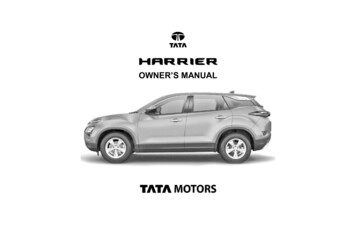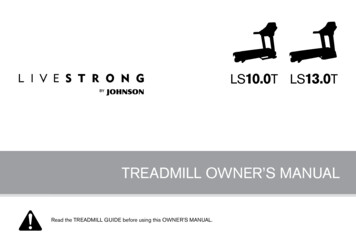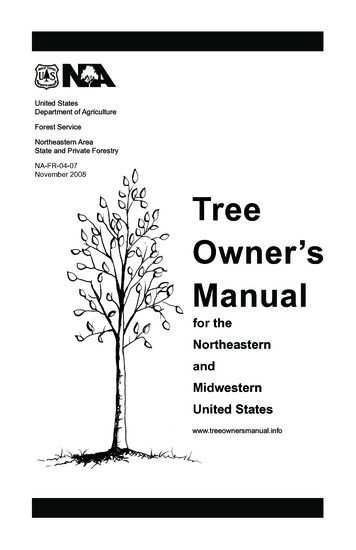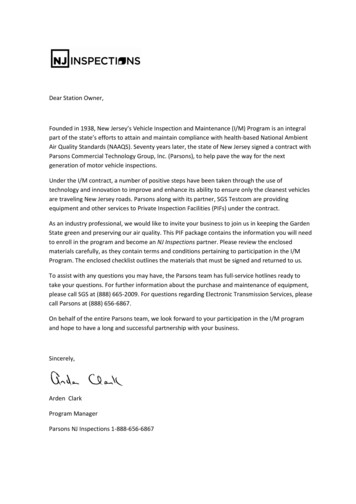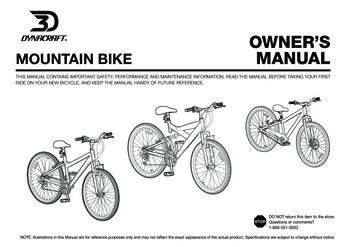
Transcription
SIMPLY CLEVERŠKODA OctaviaOwner's Manual
Layout of this Owner's Manual(explanations)This Owner's Manual has been systematically designed to make it easy for you tosearch for and obtain the information you require.Chapters, table of contents and subject indexThe text of the Owner's manual is divided into relatively short sections which arecombined into easy-to-read chapters. The chapter you are reading at any particularmoment is always specified on the bottom right of the page.The Table of contents is arranged according to the chapters and the detailed Subject index at the end of the Owner's Manual helps you to rapidly find the information you are looking for.Direction indicationsAll direction indications such as “left”, “right”, “front”, “rear” relate to the direction oftravel of the vehicle.Units of measurementAll values are expressed in metric units.Explanation of symbols Denotes a reference to a section with important information and safetyadvice in a chapter. Denotes the end of a section. Denotes the continuation of a section on the next page. Indicates situations where the vehicle must be stopped as soon as possible. Denotes a registered trademark.NotesWARNINGThe most important notes are marked with the heading WARNING. TheseWARNING notes draw your attention to a serious risk of accident or injury.CAUTIONA Caution note draws your attention to the possibility of damage to your vehicle(e.g. damage to gearbox), or points out general risks of an accident.For the sake of the environmentAn Environmental note draws your attention to environmental protection aspects.This is where you will, for example, find tips aimed at reducing your fuel consumption.NoteA normal Note draws your attention to important information about the operationof your vehicle.
PrefaceYou have opted for a ŠKODA – our sincere thanks for your confidence in us.You have received a vehicle with the latest technology and range of amenities. Please read this Owner'sManual carefully, because the operation in accordance with these instructions is a prerequisite for proper useof the vehicle.If you have any questions about your vehicle, please contact a ŠKODA Service Partner.We wish you much pleasure with your ŠKODA and pleasant motoring at all times.Your ŠKODA AUTO a.s. (hereinafter referred to as ŠKODA)
The on-board literatureThe on-board literature for your vehicle consists of this “Owner's Manual” as wellas a “Service schedule” and the “Help on the road” brochure.Depending on the vehicle model and equipment, other additional operating manuals and instructions may be provided (e.g. an operating manual for the radio).If one of the publications listed above is missing, please contact a ŠKODA ServicePartner.The Owner's ManualThese operating instructions describe all possible equipment variants withoutidentifying them as special equipment, model variants or market-dependentequipment.Consequently, this vehicle does not need to contain all of the equipment components described in this Owner's manual.The level of equipment of your vehicle refers to your purchase contract of the vehicle. For more information, contact your local ŠKODA retailer.The illustrations can differ in minor details from your vehicle; they are only intended for general information.The Service Plan:› includes vehicle data including information on service work performed;› is a record of services provided;› is provided for entries relating to the mobility warranty (valid only for somecountries);› serves as warranty certificate of the ŠKODA dealer.The service records are one of the conditions for warranty claims.Please always present the Service schedule when you take your car to a ŠKODAspecialist garage.If the Service Schedule is missing or worn, please contact the ŠKODA specialistgarage that regularly services your car. You will receive a duplicate, in which thepreviously carried out service work is confirmed by the ŠKODA specialist garage.The Help on the Road brochureThe brochure contains the important emergency telephone numbers as well astelephone numbers and contact addresses of ŠKODA Service Partners in differentcountries.
Table of ContentsAbbreviationsUsing the systemCockpitOverview76Instruments and warning lightsInstrument clusterMultifunction display (onboard computer)MAXI DOT (information display)Warning lights88121518Unlocking and lockingVehicle keyChild safety lockCentral locking systemRemote controlAnti-theft alarm systemBoot lidElectric power windowsElectric sliding/tilting roof262627273031333437Lights and visibilityLightsInterior lightVisibilityWindscreen wipers and washersRear window393945474851Seats and StowageFront seatsSeat heatersHead restraintsRear seatsBoot545457585960Variable loading floor in the bootNet partition (Combi)Roof rack systemCup holderAshtrayCigarette lighter, 12-volt power socketStorage compartmentsClothes hooksParking ticket holder646566686869707777Heating and air conditioning system79Heating and air conditioning system79Air outlet vents80Heating80Air conditioning system (manual air conditioningsystem)82Climatronic (automatic air conditioningsystem)85Auxiliary heating (auxiliary heating andventilation)87Starting-off and DrivingStarting and stopping the engineBrakes and brake assist systemsShifting (manual gearbox)pedalsParking aidCruise control system (CCS)START/STOP91919397979899100Automatic gearboxAutomatic gearbox102102CommunicationMobile phones and two-way radio systemsOperating the phone on the multifunctionsteering wheelSymbols in the information displayPhone PhonebookUniversal telephone preinstallation GSM IIUniversal telephone preinstallation GSM IIl107107108109109109112Voice controlMultimedia116118SafetyPassive SafetyGeneral informationCorrect seated position121121122Seat beltsSeat belts125125Airbag systemDescription of the airbag systemFront airbagsSide airbagsHead airbagsDeactivating airbags129129130131132133Transporting children safelyChild seat135135Driving TipsDriving and the EnvironmentThe first 1 500 kmCatalytic converterEconomical and environmentally friendlydrivingEnvironmental compatibilityDriving abroadAvoiding damage to your vehicleDriving through water on the street139139139140142143143144Towing a trailerTowing a trailer145145General MaintenanceTaking care of and cleaning the vehicleTaking care of your vehicleTable of Contents1481483
Inspecting and replenishingFuelEngine compartmentVehicle battery155155158165Wheels and TyresTyres170170Accessories, changes and replacement of partsIntroductory informationChanges and impairments of the irst-aid kit and warning triangleFire extinguisherVehicle tool kitChanging a wheelBreakdown kitJump-startingTowing the vehicle178178178179179182185186Fuses and light bulbsFusesBulbs189189191Technical dataTechnical dataIntroductory informationData on the vehicle data sticker and the typeplateDimensionsSpecifications and engine oil capacityVehicle-specific information depending onengine typeMulti-purpose vehicles (AF)4Table of Contents197197197198200201207Index
AbbreviationsAbbreviationDefinitionrpmEngine revolutions per minuteABSAnti-lock brake systemAFMulti-purpose vehiclesAGAutomatic gearboxTCSTraction controlCO2 in g/kmdischarged quantity of carbon dioxide in grams per driven kilometerDPFDiesel particle filterDSGAutomatic double clutch gearboxDSRActive driver-steering recommendationEDLElectronic differential lockEPCEPC fault lightESCElectronic Stability ControlkWKilowatt, measuring unit for the engine outputMGManual gearboxMFDMultifunction displayN1Panel van intended exclusively or mainly for the transportation of goodsNmNewton meter, measuring unit for the engine torqueTDI CRDiesel engine with turbocharging and common rail injectionsystemTDI PDDiesel engine with injection system and unit injector injectionsystemTSIPetrol engine with turbocharging and direct injectionÐAbbreviations5
Fig. 1 Cockpit6Using the system
19Using the 15161718Electric windowsElectric exterior mirror adjustmentAir outlet ventsLever for the multifunction switch:› Turn signal light, headlight and parking light, headlight flasher› Speed regulating systemSteering wheel:› With horn› With driver’s front airbag› with pushbuttons for radio, navigation system and mobilephoneInstrument cluster: Instruments and warning lightsLever for the multifunction switch:› Multifunction display› Windscreen wiper and wash systemRegulator for front left seat heatingAir outlet ventsSwitch for hazard warning lightsStorage compartment on the dash panelDepending on equipment fitted:› Radio› Navigation systemRegulator for front right seat heatingStorage compartment on the front passenger sideKey switch for switching off the front passenger airbag (in frontpassenger storage compartment)Front passenger airbagFuse box (on side of dash panel)Light switch34528045992526272813029108, 118830124857804472Regulator for the instrument lighting and regulator for the headlight beam range adjustmentBonnet release leverStorage compartment on the driver's sideLever for adjusting the steering wheelIgnition lockDepending on equipment fitted:› Operating controls for the heating› Operating controls for the air conditioning system› Operating controls for ClimatronicTCS switchFront and rear parking aidDepending on equipment fitted:› Gearshift lever (manual gearbox)› Selector lever (automatic gearbox)Tyre pressure monitoring systemDepending on equipment fitted:› Ashtrays› Storage compartmentWarning light for the deactivated front seat passenger airbag43, 441607192938082859698971031756872133NoteThe arrangement of the controls and switches and the location of some items onright-hand drive models may differ from that shown in » Fig. 1. The symbols onthe controls and switches are the same as for left-hand drive models.577113313019040Cockpit7Ð
OverviewInstruments and warning lightsInstrument clusteräIntroductionThis chapter contains information on the following subjects:OverviewEngine revolutions counterSpeedometerCoolant temperature gaugeFuel gaugeCounter for distance drivenService Interval DisplayDigital clockRecommended gear8999910101111Fig. 2 Instrument clusteräWARNINGConcentrate fully at all times on your driving! As the driver you are fully responsible for the operation of your vehicle. Never operate the controls in the instrument cluster while driving, onlywhen the vehicle is stationary!12 3Ð4568Using the systemFirst read and observe the introductory information and safety warningson page 8.Engine revolutions counter » page 9Speedometer » page 9Coolant temperature gauge » page 9Display:› With counter for distance driven » page 10› With service interval display » page 10› With digital clock » page 11› With multifunction display » page 12› With information display » page 15Knob for the selection of the mode (turn knob)/the setting (press knob):› Setting the hours/minutes› Activating/deactivating the second speed in mph or km/h› Service intervals - Display of the number of days and kilometres remaininguntil the next Inspection Service› Reset trip counter for the distance driven› Resetting Service Interval Display› Activate/deactivate display modeFuel gauge » page 9Ð
Engine revolutions counteräCoolant temperature gaugeäFirst read and observe the introductory information and safety warningson page 8.The red scale of the rev counter 1 » Fig. 2 on page 8 indicates the range in whichthe engine control unit begins to limit the engine speed. The engine control unitrestricts the engine speed to a steady limit.The coolant temperature gauge 3 » Fig. 2 on page 8 operates only when the ignition is switched on.The following guidelines regarding the temperature ranges must be observed toavoid any damage to the engine.You should shift into the next higher gear before the red scale of the revolutioncounter is reached, or move the selector lever into position D if your car is fittedwith an automatic gearbox.Cold rangeIf the pointer is still in the left area of the scale it means that the engine has notyet reached its operating temperature. Avoid high speeds, full throttle and highengine loads.To maintain the optimum motor speed, observe the gearshift indicator » page 11.The operating rangeThe engine has reached its operating temperature as soon as the pointer movesinto the mid-range of the scale, for a normal style of driving. The pointer may alsomove further to the right at high engine loads and high outside temperatures.For the sake of the environmentShifting to a higher gear in good time helps to lower fuel consumption, minimisesoperating noise levels, protects the environment and contributes to a longer lifeand reliability of the engine.ÐCAUTIONAdditional headlights and other attached components in front of the fresh air inlet impair the cooling efficiency of the coolant. There is then a risk of the engineoverheating at high outside temperatures and high engine loads » page 20.SpeedometeräFirst read and observe the introductory information and safety warningson page 8.äFirst read and observe the introductory information and safety warningson page 8.The fuel gauge 6 » Fig. 2 on page 8 only operates when the ignition is switchedon.NoteÐThe fuel tank has a capacity of about 55 litres or 60 litres 1). The warning light inthe instrument cluster lights up when the pointer reaches the reserve marking » page 23.An audible signal sounds as a warning signal.1)ÐFuel gaugeWarning against excessive speedsAn audible warning signal will sound when the vehicle speed exceeds 120 km/h.The audible warning signal is switched off when the vehicle speed falls belowthis speed limit.This function is only valid for some countries.First read and observe the introductory information and safety warningson page 8. Valid for Octavia Combi 4x4 and Octavia Scout.Instruments and warning lights9
CAUTIONService Interval DisplayNever drive until the fuel tank is completely empty! An irregular supply of fuel canlead to irregular engine running. Unburnt fuel may get into the exhaust systemand damage the catalytic converter.Fig. 3Service Interval Display: NoteNoteAfter filling up, it can occur that during dynamic driving (e.g. numerous curves,braking, driving downhill and climbing a steep hill) the fuel gauge indicates approx. a fraction less. When stopping or during less dynamic driving, the fuel gaugedisplays the correct fuel level again. This is not a fault.ÐäCounter for distance drivenäFirst read and observe the introductory information and safety warningson page 8.First read and observe the introductory information and safety warnon page 8.ingsThe display can vary depending on the equipment.Service Interval DisplayBefore the next service interval a key symbol and the remaining kilometres areindicated for 10 seconds after switching on the ignition » Fig. 3. At the same time,the remaining days until the next service interval are displayed.The distance which you have driven with your vehicle is shown in kilometres (km).In some countries the measuring unit miles (mph) is used.Daily trip counter (trip)The daily trip counter indicates the distance which you have driven since it waslast reset - in steps of 100 metres or 1/10 of a mile.The following is displayed in the information display:Service in . km or . days.Press the button 5 » Fig. 2 on page 8 for more than 1 second to reset the displayof the daily trip counter.The kilometre indicator or the days indicator reduces in steps of 100 km or, whereapplicable, days until the service due date is reached.OdometerThe odometer indicates the total distance in kilometres or miles which the vehiclehas been driven.As soon as the due date for the service is reached, a flashing key symbol andthe text Service appears in the display for 20 seconds after the ignition has beenswitched on.Fault displayIf there is a fault in the instrument cluster Error will appear continuously in thedisplay. Ensure the fault is rectified as soon as possible by ŠKODA a specialist garage.The following is displayed in the information display:Service now!Displaying the distance and days until the next service intervalYou can use the button 5 to display the remaining distance and the days untilthe next service interval » Fig. 2 on page 8.NoteFor vehicles fitted with the information display, if the display of the second speedis activated in mph or km/h, this driving speed is indicated instead of the counterfor the total distance driven.10Using the systemA key symbol and the remaining distance appear for 10 seconds in the display.At the same time, the remaining days until the next service interval are displayed.ÐOn vehicles which are equipped with the information display, you can call up this display in the menu Settings » page 16.
The following will be displayed in the information display for 10 seconds:Service in . km or . days.Resetting Service Interval DisplayIt is only possible to reset the Service Interval Display, if a service message or atleast a pre-warning is shown in the instrument cluster display.We recommend that this reset is completed by a ŠKODA specialist garage.The ŠKODA specialist garage:› Resets the memory of the display after the appropriate inspection› Adds an entry to the Service Schedule› Affixes the sticker with the entry of the following service interval to the side ofthe dashboard on the driver's sideReset the service interval display by using the knob 5 » Fig. 2 on page 8.Digital clockäFirst read and observe the introductory information and safety warningson page 8.The clock is set using the knob 5 » Fig. 2 on page 8.Turn the knob 5 to select the display you wish to change. Make the change bypressing the knob.On vehicles that are fitted with the information display, it is also possible to setthe clock in the menu Time » page 16.ÐRecommended gearOn vehicles which are equipped with the information display, you can reset theService Interval Display in the menu Settings » page 16.Fig. 4Recommended gearCAUTIONWe recommend that you do not reset the Service Interval Display yourself as thiscan result in the incorrect setting of the Service Interval Display, which can alsocause possible problems with the operation of your vehicle.NoteNever reset the display between service intervals, as this will result in the incorrect display. Information is retained in the Service Interval Display even after the vehicle battery is disconnected. If the instrument cluster is exchanged after a repair, the correct values must beentered in the counter for the Service Interval Display. This work is carried out bya ŠKODA specialist garage. After resetting the display with flexible service intervals, the displayed data isthe same as that for a vehicle with fixed service intervals. We therefore recommend that the Service Interval Display is only reset by a ŠKODA Service Partner,who will reset the display with a vehicle system tester.Ð For more information on the service intervals » Service Plan. äFirst read and observe the introductory information and safety warningson page 8.The currently engaged gear A is shown in the instrument cluster display » Fig. 4.In order to minimise the fuel consumption, a recommendation for shifting into another gear is indicated in the display.If the control unit recognises that it is beneficial to change gear, an arrow B isshown in the display. The arrow points up or down, depending on whether youshould shift into a higher or lower gear.At the same time, the recommended gear is indicated instead of the currently en gaged gear A .Instruments and warning lights11
CAUTIONMemoryThe driver is always responsible for selecting the correct gear in different drivingsituations, such as overtaking.Fig. 5Multifunction displayÐMultifunction display (onboard computer)äIntroductionThis chapter contains information on the following subjects:MemoryOperationMultifunction display detailsWarning against excessive speeds12131314äThe multifunction display is equipped with two automatic memories. The selectedmemory is shown in the Display » Fig. 5.The multifunction display can only be operated when the ignition is switched on.After the ignition is switched on, the function displayed is the one which you lastselected before switching off the ignition.The data of the single-trip memory (memory 1) is shown if a 1 appears in the display. A 2 shown in the display means that data relates to the total distance memory (memory 2).The multi-functional indicator appears in the display » Fig. 5 on page 12 or in theinformation display » page 15 depending on the equipment fitted to your vehicle.Switching over the memory using the button B » Fig. 6 on page 13 on the windscreen wiper lever or using the adjustment wheel D on the multifunction steering wheel.In vehicles with an information display » page 15, there is an option to fade outsome of the information.Single-trip memory (memory 1)The single-trip memory collates the driving information from the moment the ignition is switched on until it is switched off. New data will also flow into the calculation of the current driving information if the trip is continued within 2 hoursafter switching off the ignition. If the trip is interrupted for more than 2 hours,the memory is automatically erased.WARNINGConcentrate fully at all times on your driving! As the driver you are fully responsible for the operation of your vehicle. Do not only rely upon the information given on the outside temperature display that there is no ice on the road. Even at temperatures around 4 C, blackice may still be on the road surface – warning, drive with care! Total-trip memory (memory 2)The total-trip memory gathers data from any number of individual journeys up toa total of 19 hours and 59 minutes driving or 1 999 kilometres driven, and on vehicles which are fitted with an information display up to a total of 99 hours and59 minutes driving or 9 999 kilometres driven. The memory is deleted when either of these limits is reached and the calculation starts all over again.NoteIn certain national versions the displays appear in the Imperial system of measures. If the display of the second speed is activated in mph, the current speed is notindicated in km/h on the display. 12Using the systemFirst read and observe the introductory information and safety warnon page 12.ingsÐUnlike the single-trip memory, the total-trip memory is not deleted after a period of interruption of driving of 2 hours.
ResetingNoteAll information in the memory 1 and 2 is erased if the battery of the vehicle is disconnected.Operation› Select the desired memory.› Press and hold the button Bл Fig. 6 or D for a short while.The following readouts of the selected memory will be set to zero with the button B » Fig. 6 or D :› Average fuel consumption› Distance driven› Average speed› Driving timeÐMultifunction display detailsäFirst read and observe the introductory information and safety warningson page 12.Outside temperatureThe current outside temperature is shown in the display.Fig. 6 Multifunction display: Control elements on the windscreen wiper lever/control elements on the multifunction steering wheeläFirst read and observe the introductory information and safety warningson page 12.The rocker switch A » Fig. 6 and the button B are located on the windscreenwiper lever. Switching over and resetting is performed with the adjustment wheelD on the multifunction steering wheel.Select memory› Press the button B » Fig. 6 or D .Selecting functions using the windscreen wiper lever› Briefly press the rocker switch A » Fig. 6 up or down. This opens the individualfunctions of the multifunction display one after the other.Selecting functions using the multifunction steering wheel› Press the button C » Fig. 6.› Turn the adjustment wheel D upwards or downwards. This opens the individual functions of the multifunction display one after the other.1)If the outside temperature drops below 4 C, a snow flake symbol (warning signal for ice on the road) appears before the temperature indicator and an audiblesignal will sound. After pressing the rocker switch A » Fig. 6 on page 13 or C ,the function shown last is indicated.Driving timeThe driving time which has elapsed since the memory was last erased, appears inthe display. If you wish to measure the driving time from a particular time, youneed to set the memory to zero at this point in time by pressing the buttonB » Fig. 6 on page 13 or D for more than 1 second.The maximum time indicated in both memories is 19 hours and 59 minutes and onvehicles which are fitted with an information display, it is 99 hours and 59 minutes. The indicator is set back to zero if this period is exceeded.Current fuel consumptionThe current fuel consumption level is shown in the display in litres/100 km1). Youcan use this information to adapt your driving style to the desired fuel consump tion.On some models in certain countries, the display appears in kilometres/litre.Instruments and warning lights13
The display appears in litres/hour if the vehicle is stationary or driving at a lowspeed1) .Average fuel consumptionThe average fuel consumption since the memory was last erased is shown in thedisplay in litres/100 km2) » page 12.If you wish to determine the average fuel consumption over a certain period oftime, you must set the memory at the start of the new measurement to zero using the button B » Fig. 6 on page 13. After erasing the memory, no value appearsin the display until you have driven 300 m.The display is updated regularly while you are driving.RangeThe estimated range in kilometres is shown on the display. It indicates the distance you can still drive with your vehicle based on the level of fuel in the tankand the same style of driving.The display is shown in steps of 10 km. After lighting up of the warning light forthe fuel reserve the display is shown in steps of 5 km.The fuel consumption over the last 50 km is used to calculate the range. Therange will increase if you drive in a more economical manner.If the memory is set to zero (after disconnecting the battery), the fuel consumption of 10 ltr./100 km is calculated for the range; afterwards the value is adaptedaccordingly to the style of driving.Distance travelledThe distance driven since the memory was last erased appears in the display » page 12.If you wish to measure the distance travelled from a particular point in time, youneed to set the memory to zero at this point in time by pressing the buttonB » Fig. 6 on page 13 or D .The maximum distance indicated in both memories is 1 999 km or 9 999 km onvehicles with an information display. The indicator is set back to zero if this periodis exceeded.1)2)On some models in certain countries, the display appears in --,- kilometres/litres if the vehicle is stationary.On some models in certain countries, the display appears in kilometres/litre.14Using the systemAverage speedThe average speed since the memory was last erased is shown in the display inkm/hour » page 12. If you wish to determine the average speed over a certain period of time, you need to set the memory to zero at the start of the measurementusing the button B » Fig. 6 on page 13 or D .After erasing the memory, no value appears in the display until you have drivenapprox. 300 m.The display is updated regularly while you are driving.Current speedThe current speed which is identical to the display of the speedometer 2 » Fig. 2on page 8 is indicated on the display.Oil temperatureIf the oil temperature is lower than 50 C or if a fault in the system for checkingthe oil temperature is present, - -.- is displayed instead of the oil temperature.ÐWarning against excessive speedsäFirst read and observe the introductory information and safety warningson page 12.Adjust the speed limit while the vehicle is stationary› With the button A » Fig. 6 on page 13 or, if applicable, the adjustment wheelD , select the menu item Warning against excessive speeds.› Press the button B or D to activate the ability to set the speed limit (valueflashes).› Set the desired speed limit, e.g. 50 km/h, with the button A or, if applicable,the adjustment wheel D .› Press the button B or D to confirm the set speed limit, or wait approx. 5 seconds and the setting is saved automatically (the value stops flashing).This allows you to set the speed in 5 km/h intervals.Adjusting the speed limit while the vehicle is moving› With the button A » Fig. 6 on page 13 or, if applicable, the adjustment wheelD , select the menu item Warning against excessive speeds.› Drive at the desired speed, e.g. 50 km/h.
› Press the buttonB or D to accept the current speed as the speed limit (theCAUTIONvalue flashes).Pull out the ignition key if coming in contact with the display (e.g. when cleaning)to prevent any possible damage.If you wish to change the set speed limit, it is changed in 5 km/h intervals (e.g. theaccepted speed of 47 km/h increases to 50 km/h or decreases to 45 km/h).› Press again the button B or D to confirm the speed limit, or wait approx. 5seconds and the setting is saved automatically (the value stops flashing).ÐMain menuChange or delete speed limit› With the button A » Fig. 6 on page 13 or, if applicable, the adjustment wheelD , select the menu item Warning against excessive speeds.› Pressing the button B or D deletes the speed limit.› Pressing the button B or D again activates change mode for the speed limit.If the set speed limit is exceeded, an audible signal will sound as a warning. Atthe same time the message Warning against excessive speeds appears on thedisplay with the set limit value.The set speed limit value remains stored even after switching off the ignition.ÐFig. 7 Information display: Control elements on the windscreen wiper lever/control elements on the multifunction steering wheelMAXI DOT (information display)ääIntroductionThis chapter contains information on the following subjects:Main menuSettingsDoor,
The on-board literature The on-board literature for your vehicle consists of this “Owner's Manual” as well as



